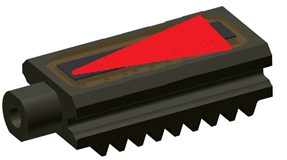Hi,
I want to measure linear displacement of a rack in a rotary to linear actuator. The rack is made of PH13-8Mo SS and I want to put a raised triangular feature on the top of it as pictured below.
The question I have are:
1. Will the metal behind the red triangle interfere with the measurement?
2. What material should the red triangle be made out of/ could it be made out of the same material as the rack?
3. If the answer to #1 is yes could the the red triangle protrude in the z direction enough to not have the metal behind it interfere with the measurement?
Thanks in advance for the help.


